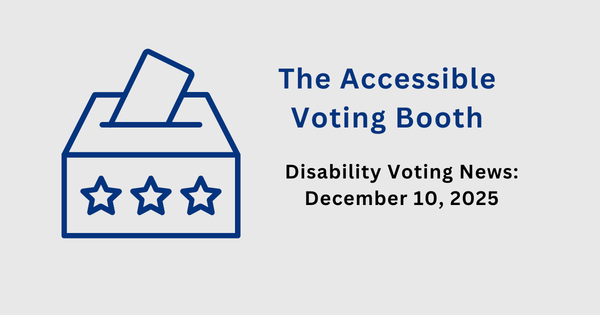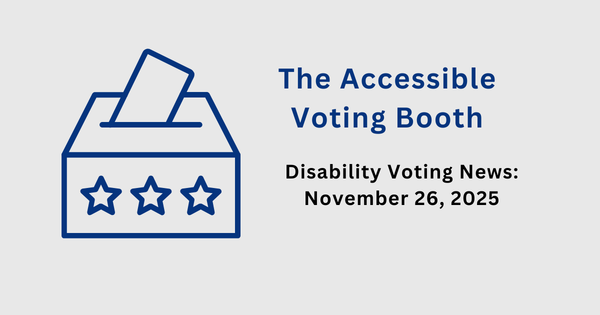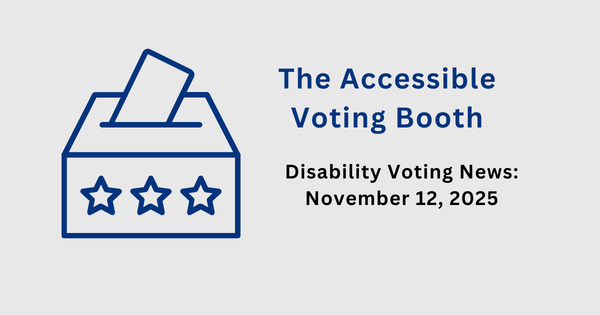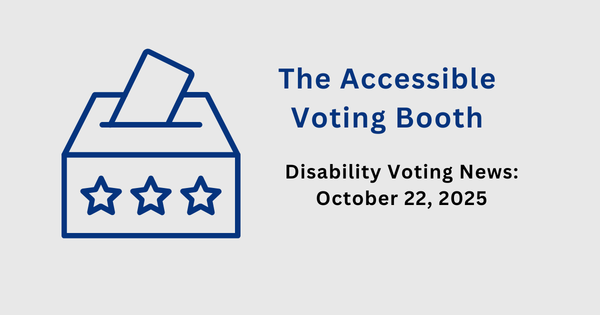Disability Voting News: June 4, 2025

Welcome to the first Accessible Voting Booth of June 2025! I’m back after a brief hiatus last week to share a few important updates. I haven’t had much time to dive into state-level voting law changes–there’s been a lot going on (as I will cover in this newsletter) and so I hope to get back to state news next week. This week, we’re talking about Detroit Disability Power’s 2024 polling place accessibility audit in Metro Detroit, how the Trump administration is rescinding guidance on voting accessibility, and the Supreme Court’s dismissal of challenges to no-excuse absentee voting, automatic voter registration, and Election Day voting in Michigan.
Just a quick note: I may have to move this newsletter to a biweekly (as in once every other week, since "biweekly" means two things) schedule. I'm thrilled to say that with my clients at Landmark Virtual Assistance, I'm back up to working full time! To maintain the quality of this newsletter, I'm considering spacing out the newsletters, and I'll keep you all updated on my decision.
Center for American Progress Seeking Input from Persons Under Guardianship Who Cannot Vote
From Casey Doherty, Policy Analyst for the Disability Justice Initiative at the Center for American Progress: “I am looking to speak with someone who is under guardianship and cannot vote. We can speak by phone, over Zoom, via email, or you can send in a statement in response to a few questions (or any other format that works for you). I will send the questions over in advance.” You can reach out to Casey at cdoherty@american.progress.org.
Detroit Disability Power Audits 294 Polling Places in Metro Detroit; Only 13% are Fully Accessible
Since 2022, I have had the privilege of working with Detroit Disability Power (DDP) on their poll audit program through my role as U.S. Voting Rights Expert at The Carter Center. DDP dispatches observers to evaluate the exterior and interior accessibility of polling places during elections, evaluating the accessibility of parking and pathways, entrances, accessible voting equipment, and wheelchair-height voting booths. During the November 2022 election, they evaluated 261 polling places and found that only 16% were fully accessible.
Last Wednesday, Detroit Disability Power released its report “The Right to a Private & Independent Ballot: Polling Site Accessibility for Michigan Voters with Disabilities in the 2024 Election.” DDP visited 294 polling places during August and November 2024 elections and found that only 13% were fully accessible. Let’s dig into some of the data.
First, for some background: I have supported DDP’s audits mainly through cleaning, analyzing, and reporting on the data. I’ve spent the last six months cleaning data, analyzing various metrics, and reporting out findings to be included in the report. The spreadsheets where I worked on these became a virtual home for me! So I’m very nerdy when it comes to talking about the data, and this may get a bit lengthy. (Note: what follows are my own opinions and not representative of any organizations with whom I am affiliated, including The Carter Center and Detroit Disability Power).
I encourage you to read the entire report, but I want to pull out a few important pieces to discuss:
The decrease from 16% accessible in 2022 to 13% accessible in 2024.
First, you may be wondering about the drop from 16% in 2022 to 13% in 2024. What caused that? Did polling place accessibility get worse from 2022 to 2024?
Of the 294 sites visited in 2024, 242 were visited in both 2022 and 2024. The remaining sites either were added or changed from 2022. We compared the data on these 242 sites and found that 15% were fully accessible in 2022, but only 9% were fully accessible in 2024, so there is a definite decrease there. Most notably, while the accessibility of entrances and the accessible voting machine improved from 2022 to 2024, accessible parking and pathway decreased by 21 percentage points, pointing to an increase in access barriers outside of the polling place. The accessibility of wheelchair-height voting booths also decreased by 6 percentage points. I also separately analyzed the sites that were new or changed in 2024. 13% were accessible, so the new sites in 2024 were just as accessible as the average for all of the sites.
However, there are other factors that can influence this change. DDP’s observers had more practice on analyzing accessibility by 2024 and were much more familiar with the survey, so data quality likely improved from 2022 to 2024. Additionally, we made edits to the survey questions between 2022 and 2024, adding one question and refining other questions so that they were clearer and more comprehensive. So while accessibility may have decreased, 2024's data is probably of slightly higher quality than it was in 2022.
Structural vs operational accessibility
I like to break down access barriers into two buckets: structural and operational accessibility.
Structural: Is the access barrier due to a structural or architectural issue with the polling place, such as cracked pavement or pathways outside of the building, steps into the building with no ramp, or broken automatic door buttons?
Operational: is the access barrier due to the way the polling place is set up or operated? This can include a lack of clear and accessible signage to the voting area, improper setup of the accessible voting equipment, propping doors open with trash cans and creating obstructions for mobility device users, or a lack of turning space around the accessible voting equipment for wheelchair users. Those are operational barriers.
Some of the questions in the survey analyze polling place features that could have structural or operational barriers. For example: “Was the path from the parking space to the building entrance paved and clear of stairs, narrow doorways, and physical obstacles that would make it hard for a wheelchair user of visually impaired person to enter?” Observers can encounter structural barriers, such as cracked pavement or a lack of curb cuts, or they could encounter operational barriers, such as a poll worker placing signs in the middle of a sidewalk.
Operational barriers are often the easiest and most cost-effective problems to fix in the polling place as they can be addressed through poll worker training. Election officials can train poll workers to ensure that paths of travel are clear of obstacles such as signs, entrances are clearly labeled, and accessible voting equipment and wheelchair-height voting booths are set up.
There are two measures in DDP’s survey that are entirely operational barriers: the accessible voting equipment (called the Voter Access Terminal, or VAT) and the wheelchair-height voting booth. These features only exist during elections, so they are completely under the control of poll workers. Unfortunately, only 58% of polling places had fully accessible VATs, and only 58% of polling places had fully accessible wheelchair-height voting booths. These issues are the “low-hanging fruit” when it comes to fixing access barriers, because their solutions involve:
- Ensuring that accessible voting equipment is set up, powered on, and at wheelchair height. Unfortunately some polling places’ equipment was not powered on or was stuck on an error screen.
- Plugging in headphones and accessible controllers. In many cases, this equipment either wasn’t at the machine or wasn’t plugged in. One poll worker proclaimed that because VATs have touch screens, a controller isn't needed (controllers are essential for nonvisual access).
- Making sure that accessible voting equipment is set up in a way that provides privacy. Many VATs were set up with their screens facing paths of travel or without privacy screens. Some poll workers used the VAT station as a desk or break area.
- Setting up a wheelchair-height voting booth for marking paper ballots, and making sure that it is set up with privacy in mind. Some poll workers didn’t even know about the wheelchair-height voting booth, and so they didn’t set it up.
By improving poll worker training on these issues, election officials can significantly improve polling place accessibility without spending a dime.
Structural barriers can be more challenging to fix, as election officials often don’t have the money or authority to address architectural barriers of polling places such as broken door opening buttons, cracked pavement, or improper ramps. However, election officials still have an obligation to make polling places accessible. Detroit Disability Power and other disability rights organizations such as Protection and Advocacy agencies are ready and eager to work with election officials to fix these access barriers, and these organizations have the knowledge and lived experience to collaborate with election officials to improve polling place accessibility. Election officials should see DDP as a resource and a partner that is there to help them remediate these barriers.
Accessibility by Building Type
The last piece of data I want to talk about is a new type of analysis we conducted this year. Polling places are required by law to be accessible. However, the buildings that election officials can use as polling places have different accessibility requirements outside of Election Day. The two most common places used in Southeast Michigan as polling places are public schools and places of worship. Outside of Election Day, public schools are required by Title II of the Americans with Disabilities Act to be accessible–that accessibility is necessary so that students, faculty, and staff with disabilities have equal access to education and to their workplaces. Meanwhile, places of worship are exempt from the Americans with Disabilities Act. With this in mind, are polling places in public schools more accessible than polling places in churches?
I decided to look at the accessibility of polling places by accessibility policy outside of Election Day to see what I could find. I categorized polling places by four accessibility policies: ADA Title II (government buildings, libraries, public schools, fire houses, community centers, etc), ADA Title III (most were nonprofit offices), Fair Housing Act (community centers in private residential settings), and exempt (places of worship and religious schools). There were only 13 ADA Title III locations and 8 Fair Housing Act locations. The vast majority of locations were ADA Title II (180) or Exempt (93). When looking at all four metrics, both ADA Title II locations and exempt locations were only 13% accessible. However, this includes data on the accessible voting equipment and the wheelchair-height voting booth, purely operational accessibility measures that have nothing to do with the structure of the building.
To more accurately analyze structural/architectural accessibility, I isolated the first two metrics, which include structural barriers: parking and pathway and building entrance. Polling places that were in buildings that fall under Title II of the ADA were 36% accessible, while polling places in exempt buildings were 30% accessible.
I have mixed feelings on this. Polling places are required to be accessible. Those numbers should be much higher for all of the buildings regardless of whether they’re required to be accessible outside of election season. But only 36% of the buildings that are required by law to be accessible year round to people with disabilities are accessible. Those access barriers persist for disabled students going to public schools and residents going to libraries, city halls, and other places.
There’s much more in this report than I could possibly cover in this newsletter, including examples of the barriers that observers found during their audits, accessibility by building type and jurisdiction, recommendations on how to fix these access barriers, and recommendations for government officials on improving voting access in Michigan. I hope you’ll take the time to read through it!
NIST to Delete Report and Guidance on Training Poll Workers to Support Voters Using Accessible Voting Systems.
In the past, I briefly mentioned that in 2022, I worked with the Center for Civic Design on a project for the National Institute of Standards and Technology on poll worker training. When poll workers aren’t prepared and trained on how to use accessible voting machines and how to appropriately support voters in a way that protects their privacy and independence, voters with disabilities experience access barriers at the polling place. As I covered in the report for this project, the National Council on Disability found in a 2012 survey that 25% of nearly 900 voters with disabilities named untrained poll personnel as a barrier, and 45% reported barriers with using the voting machines.
During this project, I spoke with voters with disabilities and disability voting rights advocates about the barriers they encounter when using accessible voting machines, and I reviewed poll worker training from around the country. In response, I produced a report, but more importantly, a model poll worker training deck that election officials could customize to their jurisdiction’s equipment and voting processes to more comprehensively train poll workers on how to support voters using accessible voting equipment. The training covered disability rights during voting, accessible voting systems’ features and how voters can use them, best practices for assisting voters with disabilities on Election Day, how to assist voters through the voting process, and additional resources.
The aim of this project was to give election officials a comprehensive resource that they can tailor to their voting equipment, state laws, and needs to better train poll workers on assisting voters with disabilities, ensuring that voters with disabilities are able to vote privately and independently.
Last week, my colleague Whitney Quesenbery at the Center for Civic Design reached out to me to inform me that the National Institute of Standards and Technology contacted her with a message: In accordance with Sec. 9 in President Trump’s Executive Order “Preserving and Protecting the Integrity of American Elections,” (March 5, 2025), our report SP1273 on Promoting Access to Voting: Recommendations for Addressing Barriers to Private and Independent Voting for People with Disabilities is being removed from the NIST website and withdrawn from the DOI link. (As of June 4, 2025, the report still seems to be available at the DOI link).
Section 9 of this EO called for all federal agencies to cease agency actions implementing President Biden’s Executive Order 14019 of March 7, 2021, Promoting Access to Voting. This report and poll worker training were created as a result of Biden’s Executive Order, which had explicitly addressed barriers for voters with disabilities in Section 7:
“Ensuring Equal Access for Voters with Disabilities. Within 270 days of the date of this order, the National Institute of Standards and Technology (NIST) within the Department of Commerce shall evaluate the steps needed to ensure that the online Federal Voter Registration Form is accessible to people with disabilities. During that period, NIST, in consultation with the Department of Justice, the Election Assistance Commission, and other agencies, as appropriate, shall also analyze barriers to private and independent voting for people with disabilities, including access to voter registration, voting technology, voting by mail, polling locations, and poll worker training. By the end of the 270-day period, NIST shall publish recommendations regarding both the Federal Voter Registration Form and the other barriers it has identified.”
This is disappointing but completely unsurprising news. As soon as President Trump had announced that he would be rescinding Biden’s Executive Order 14019, I prepared for this by downloading the report and training. Ensuring that people with disabilities are able to privately and independently vote, and dismantling the barriers to voting for marginalized groups, are not threats–the true threat here is stripping guidance and resources that will support election officials in ensuring that everybody has the same right and access to cast their ballots.
U.S. Supreme Court Declines to Hear Republican Challenge to Voter-Approved Election Law
In the March 26th edition of The Accessible Voting Booth, I covered how a dozen Republican lawmakers in Michigan petitioned the Supreme Court to declare voter-approved election laws passed in 2018 and 2022 unconstitutional. Ballot Proposal 2 and Ballot Proposal 3 authorized automatic and Election Day voter registration and no-excuse absentee voting. As I covered in that issue, these provisions improve election access for people with disabilities by increasing access to voter registration and ensuring that people do not need to have a qualifying reason to use absentee voting.
This case had been dismissed in a lower court due to lack of standing, and that dismissal had been upheld by the 6th U.S. Circuit Court of Appeals. The U.S. Supreme Court has now rejected the conservative lawmakers’ appeal, leaving these election laws, and access to no-excuse absentee voting, Election Day voter registration, and automatic voter registration, in place. While the case had been considered a long shot, this is still a great relief.
Thank you for reading this week’s edition of The Accessible Voting Booth! As always, if you’d like to support the newsletter and my work, here’s how:
- Subscribe to the Accessible Voting Booth newsletter.
- Share this newsletter with your network to spread the word about disability voting rights.
- Leave me a tip. Thank you for supporting my work!




